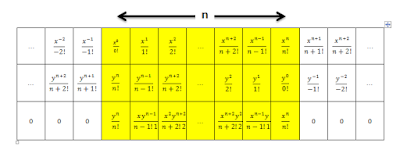You can visit Symmetric polynomial webpage on this link
http://en.wikipedia.org/wiki/Symmetric_polynomial#Monomial_symmetric_polynomials
Monomial symmetric polynomials is nice notation for symmetric polynomials especially when the polynomial becomes so long expression like,
$M_{(1,2)}(a,b,c,d,e)=ab^2+ac^2+ad^2+ae^2+ba^2+bc^2+bd^2+be^2+ca^2+cb^2+cd^2+ce^2+da^2+db^2+dc^2+de^2+ea^2+eb^2+ec^2+ed^2$
In this post I will give nice logic relations of Monomial symmetric polynomials, which can help to solve polynomial equations like cubic and quadric equations.
Now check this logic relations
1) $(a^2+b^2)-(a+b)(a+b)+ab(a^0+b^0)=0$
2) $(a^3+b^3+c^3)-(a+b+c)(a^2+b^2+c^2)+(ab+bc+ca)(a+b+c)-abc(a^0+b^0+c^0)=0$
For the next relation I will use the notation of Monomial symmetric polynomials
3) $M_{(4)}(a,b,c,d) - M_{(1)}(a,b,c,d) \cdot M_{(3)}(a,b,c,d) + M_{(1,1)}(a,b,c,d) \cdot M_{(2)}(a,b,c,d) - M_{(1,1,1)}(a,b,c,d) \cdot M_{(1)}(a,b,c,d) + M_{(1,1,1,1)}(a,b,c,d) \cdot M_{(0)}(a,b,c,d)=0$
And for more general form for 4 variables $(a,b,c,d)$ we have,
$M_{(n)}(a,b,c,d) - M_{(m)}(a,b,c,d) \cdot M_{(n-m)}(a,b,c,d) + M_{(m,m)}(a,b,c,d) \cdot M_{(n-2m)}(a,b,c,d) - M_{(m,m,m)}(a,b,c,d) \cdot M_{(n-3m)}(a,b,c,d) + M_{(m,m,m,m)}(a,b,c,d) \cdot M_{(n-4m)}(a,b,c,d) =0 $
for $(n = 4m)$
Or
$M_{(n)}(a,b,c,d) - M_{(m)}(a,b,c,d) \cdot M_{(n-m)}(a,b,c,d) + M_{(m,m)}(a,b,c,d) \cdot M_{(n-2m)}(a,b,c,d) - M_{(m,m,m)}(a,b,c,d) \cdot M_{(n-3m)}(a,b,c,d) + M_{(n-3m,m,m,m)}(a,b,c,d) =0$
for $(n \gt 4m)$
If we want to generalize the formula for unknown number of variables $(a_1,a_2, \cdots , a_n)$
We should have new definition of extended Monomial symmetric polynomials.
Let us define $M_{(k)}^{(n)}(a_1,a_2,\cdots , a_n)$ as a Monomial symmetric polynomials that has $n$ number of $k$ powers for the given variables.
So I can say:
$$M_{(k)}^{(n)}(a_1,a_2,\cdots , a_n)=M_{(k,k, … k)}(a_1,a_2, \cdots , a_n)$$ $k$ is repeated $n$ times.
The new definition will help us to construct a formula to generalize a relation for unknown number of variables $(a_1,a_2, \cdots , a_n)$
So we have,
$$\sum_{m=0}^{n}\left( (M_{(n-m)}^{(j)}(a_1,a_2, \cdots , a_n))\cdot \sum_{1}^{n} a_k^{jm}\right)=0$$
$j \in \Bbb N$


